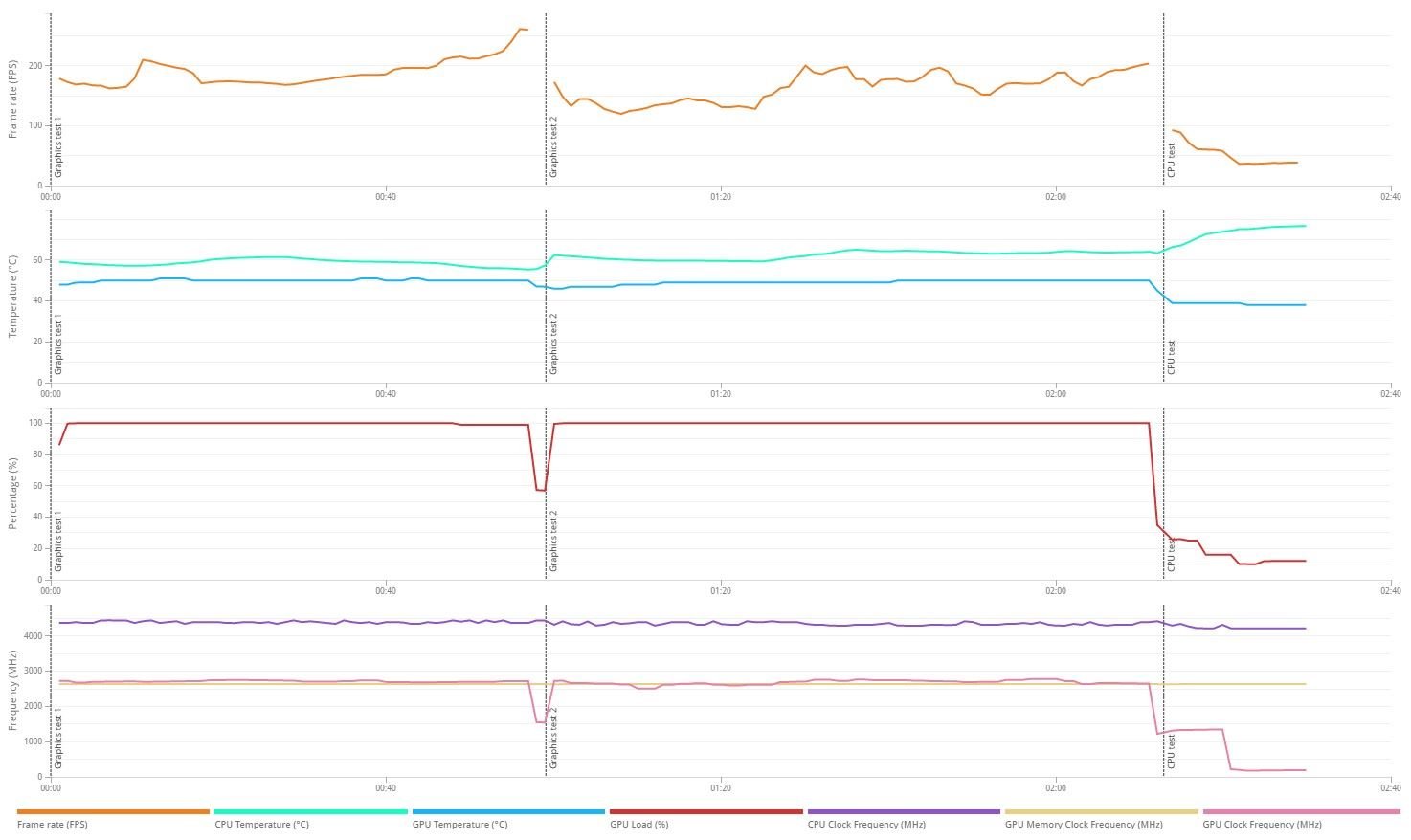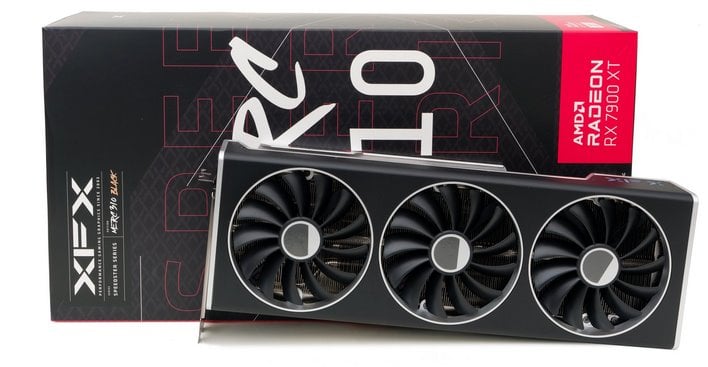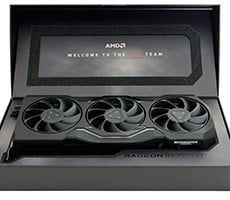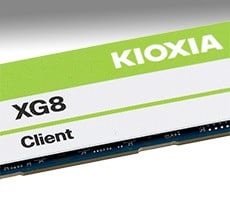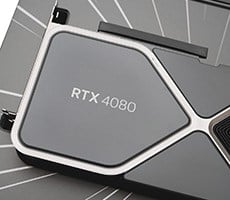XFX MERC 310 Radeon RX 7900 XT Review: Bigger, Badder RDNA 3
While new RDNA 3-based Radeons have de-coupled front end and shader clocks, which may seem to complicate things, the two clock domains are linked, so the the actual overclocking process is similar to previous-gen cards.
The tuning options built into AMD's driver suite give users the ability to manually alter frequencies, voltages, fan speeds, and the max power target, using percentages or finer-grained numerical sliders. Users can also opt to use various preset modes or auto-tune a number of characteristics, including GPU and memory frequencies as well as the GPU voltage, including under-volting.
With older Radeons, a single sensor had been used to determine the GPU temperature, and data from that lone sensor was used to control the card's thermal profile. With newer RDNA 2 and RDNA 3 GPUs, like the Navi 31 powering the XFX MERC 310 Radeon RX 7900 XT, AMD has incorporated a network of multiple thermal sensors at strategic locations across the die. Data gathered from the sensors is used to determine what AMD calls the "Junction Temperature", and it's the Junction Temperature that is used to tune the card's power and thermal profiles (the Junction Temperature is effectively the hottest part of the GPU die at any given time).
The tuning options built into AMD's Radeon Software suite offer manual controls, along with automatic under-volting and automatic GPU and Memory overclocking. Finding the highest stable memory and GPU clocks, at the lowest voltage possible, while simultaneously increasing the max power target and keeping temperatures low, is what will yield the best overall overclocking results. If you'd rather not mess around though, you could simply enable Rage Mode, which essentially increases the power target and fan speeds, to effectively increase the game / boost clocks, and squeeze out a bit of extra performance with a single-click.
At its stock settings, we saw the XFX MERC 310 Radeon RX 7900 XT's GPU clock typically hovering in the 2,600 - 2,700MHz range while gaming (give or take) with our particular sample. With some tweaking we found that we could easily increase the memory clock on our card to 2,648MHz (21.1Gbps, effective), and with a mild under-volt to 1.075mV, a max frequency set to 2,899MHz, and +15% to the power target, we typically saw a wider-range of real-world game clocks, commonly in the 2,800MHz - 2,900MHz range. The junction temperature while overclocked peaked in the mid 70°C range with these settings, with a slight bump to the fan curve into the 2,000-ish RPM range. The cooling setup on this card does a nice job keeping temperatures in check.
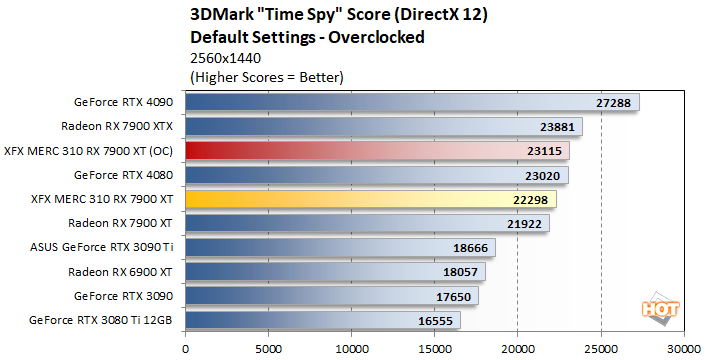
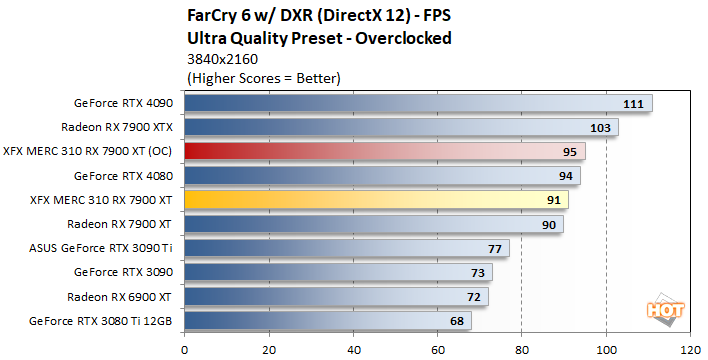
While we had the card overclocked, we re-ran a couple of tests and realized some decent performance gains. In both 3DMark Time Spy and FarCry 6 (using RT), overclocking the XFX MERC 310 Radeon RX 7900 XT allowed the card to overtake the GeForce RTX 4080, and inch closer to the performance of a higher-end Radeon RX 7900 XTX.
Total System Power Consumption Testing
We'd also like to cover a couple of final data points regarding power consumption and acoustics before we wrap up. Throughout all of our benchmarking and testing, we monitored noise output and tracked how much power the our test system was consuming using a power meter. Our goal was to give you an idea as to how much power each GPU used while idle and also while under a heavy workload. These power numbers were captured during a FarCry 6 4K benchmark run with ray tracing enabled...
In terms of noise output, the XFX MERC 310 Radeon RX 7900 XT is relatively tame when running at stock settings, but it does emit slightly more noise than AMD's cards under load. The cards' fans typically hovered around 1,500 - 1,600 RPM under long sustained loads, which produced a dull, deep whir that wasn't particularly noticeable over our test system's PSU fans and CPU cooler. If you enable Rage mode for a quick boost to performance, however, the fan curve gets more aggressive and the XFX MERC 310 Radeon RX 7900 XT will produce audibly more noise.
XFX MERC 310 Radeon RX 7900 XT Performance And Review Summary
Generally speaking, the XFX MERC 310 Radeon RX 7900 XT offers more performance than AMD’s own Radeon RX 7900 XT and its runs cooler too, thanks in no small part to the card’s massive heatsink assembly. That additional performance, however, comes at the cost of slightly higher power and a form factor that won’t fit in every PC case. At 13.5” long, 5” high and 2.7 slots wide, the XFX MERC 310 Radeon RX 7900 XT is one heck of a beefy graphics card. Make sure you’ve got the clearance to install one of these bad boys before taking the plunge.
Although probably not a big deal for most, XFX also tweaked the output configuration on this card. If you dug the USB-C ports on AMD’s designs, you unfortunately won’t find one on the XFX MERC 310 Radeon RX 7900 XT – it’s got a third full-sized DisplayPort instead.
In terms of pricing, XFX expects the cards to land in the $949 - $979 price range. On one hand, that’s not a particularly large premium to pay over a stock Radeon RX 7900 XT. One the other hand, it’s only $20 - $50 away from the faster Radeon RX 7900 XTX, which also has more memory on board (24GB vs. 20GB), that is if street prices for AMD's card land near their MSRP. If the performance of the XFX MERC 310 Radeon RX 7900 XT is adequate for your needs and you’d rather save a few bucks, it’s certainly a fine GPU. Just know that there’s more performance and potentially some additional future-proofing to be had for a small, additional cost.


